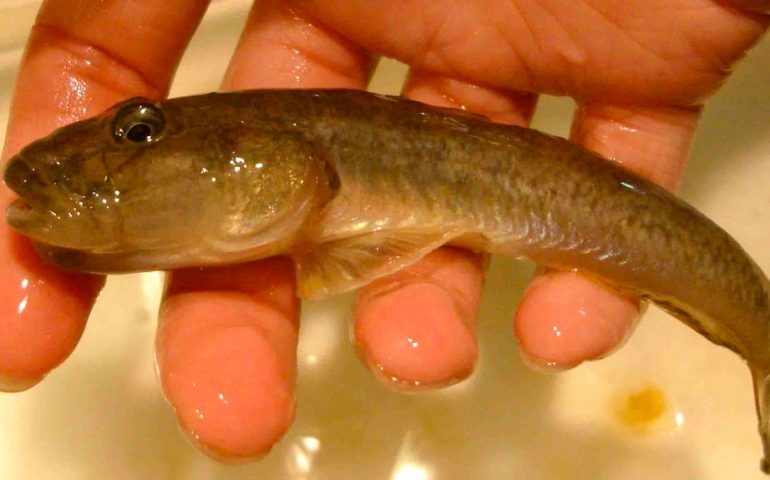Gobies: Family Gobiidae
Species: Gillichthys mirabilis (Cooper, 1864); from the word gillichthys (gill fish, named in honor of the 19th Century American ichthyologist Theodore Gill) and the Latin word mirabilis (wonderful).
Alternate Names: Mudsucker. Called chupalodo grande or gobio in Mexico.
Identification: Typical goby shape but slender; distinguished by a very large head and mouth. Both the upper and lower jaws have teeth that are conical and inclined backwards. Their coloring is olive brown with a yellowish belly; their fins are olive green. Both dorsal fins and anal fins are usually heavily pigmented, almost black, dusky in pale specimens with white margins. Second dorsal fin rarely with traces of two to three horizontal stripes.
Size: Up to 8.3 inches. Most caught from piers are under 6 inches.
Range: Gulf of California, Bahia Magdalena, southern Baja California, to Tomales Bay, northern California. Common from southern Baja California, to Tomales Bay.
Habitat: Shallow-water mudflat areas in bays and lagoons. Recorded to a depth of 15 feet. Mudsuckers have developed the ability to breath air out of water and if conditions become too severe in their home in the mud, they can simply “walk” with their pectoral fins to a better spot.
Piers: Occasionally caught off piers, primarily those in southern California bays. Best bets: Bayside Park Pier, Oceanside Small Craft Harbor Pier, Dana Point Harbor Pier, Seal Beach Pier, Arrowhead Marsh Fishing Piers and San Antonio Pier.
Shoreline: Primarily caught by anglers fishing sandy areas in bays.
Boats: An inshore species rarely take from boats.
Bait and Tackle: Caught while fishing on the bottom for other species. Since small themselves, most are taken by anglers using small hooks when fishing for perch or turbot.
Food Value: Too good of a bait to even consider using as food. Striped bass, as well as many other game fish, consider them an excellent meal.
Comments: Not to many fish have records (CDs?) named after them or, for that matter, a band. However, there is a band called Mudsuckers and the following comes from the Pitchfork’s review of their 2006 CD Mudsuckers: “Evolution—or at least reproduction, its by-the-episode catalyst—favors survival. As such, nature claims several fairly intricate means to that end, systems of existence that make the ‘Live, eat, f…, die’ model a bit reductive. The millimeter-long tardigrade, for instance, can end its metabolism, enter a state of indefinite cryobiosis, and emerge as healthy as ever in favorable conditions years later. Though the California coastline’s coolest goby fish, the longjaw mudsucker, is a bit less dramatic, it’s every bit as industrious: A native of tidal zones, the mudsucker is often left without water for swimming during low tides. It survives by crawling into a self-made burrow, sealing it with mud and entering a state of hypoxia. Quite literally, it breathes the air and ingests and excretes the swarm of microscopic invertebrates it sucks from surrounding mud.”

How many hooks can be used for mudsuckers